lock TOYOTA RAV4 PLUG-IN HYBRID 2023 Owner's Guide
[x] Cancel search | Manufacturer: TOYOTA, Model Year: 2023, Model line: RAV4 PLUG-IN HYBRID, Model: TOYOTA RAV4 PLUG-IN HYBRID 2023Pages: 718, PDF Size: 167.55 MB
Page 125 of 718
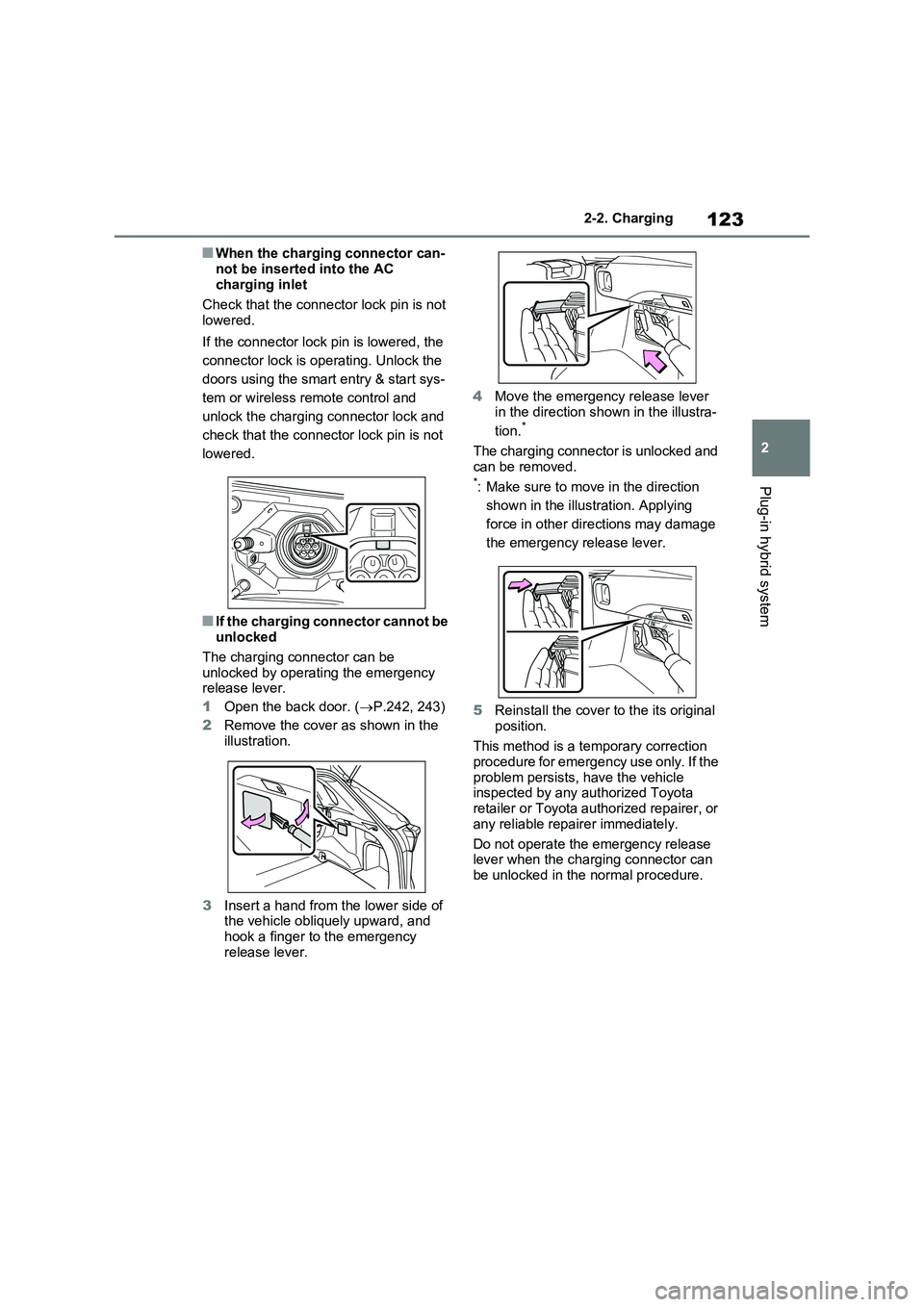
123
2
2-2. Charging
Plug-in hybrid system
■When the charging connector can-
not be inserted into the AC charging inlet
Check that the connector lock pin is not
lowered.
If the connector lock pin is lowered, the
connector lock is operating. Unlock the
doors using the smart entry & start sys-
tem or wireless remote control and
unlock the charging connector lock and
check that the connector lock pin is not
lowered.
■If the charging connector cannot be unlocked
The charging connector can be
unlocked by operating the emergency release lever.
1 Open the back door. (P.242, 243)
2 Remove the cover as shown in the illustration.
3 Insert a hand from the lower side of the vehicle obliquely upward, and
hook a finger to the emergency release lever.
4 Move the emergency release lever
in the direction shown in the illustra-
tion.*
The charging connector is unlocked and
can be removed.*: Make sure to move in the direction
shown in the illustration. Applying
force in other directions may damage
the emergency release lever.
5 Reinstall the cover to the its original
position.
This method is a temporary correction procedure for emergency use only. If the
problem persists, have the vehicle inspected by any authorized Toyota retailer or Toyota authorized repairer, or
any reliable repairer immediately.
Do not operate the emergency release lever when the charging connector can
be unlocked in the normal procedure.
Page 126 of 718
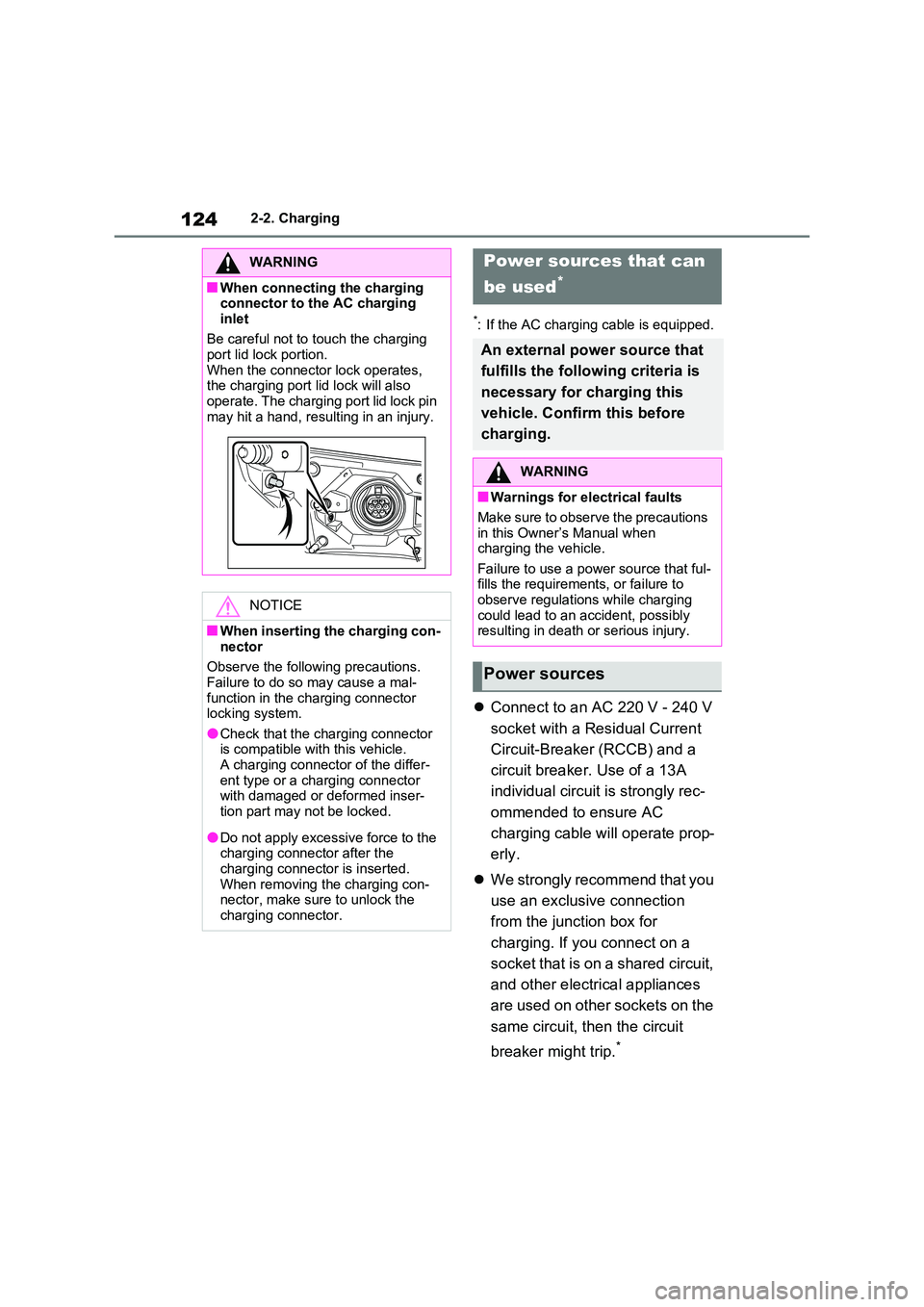
1242-2. Charging
*: If the AC charging cable is equipped.
Connect to an AC 220 V - 240 V
socket with a Residual Current
Circuit-Breaker (RCCB) and a
circuit breaker. Use of a 13A
individual circuit is strongly rec-
ommended to ensure AC
charging cable will operate prop-
erly.
We strongly recommend that you
use an exclusive connection
from the junction box for
charging. If you connect on a
socket that is on a shared circuit,
and other electrical appliances
are used on other sockets on the
same circuit, then the circuit
breaker might trip.*
WARNING
■When connecting the charging connector to the AC charging
inlet
Be careful not to touch the charging port lid lock portion.
When the connector lock operates, the charging port lid lock will also operate. The charging port lid lock pin
may hit a hand, resulting in an injury.
NOTICE
■When inserting the charging con-
nector
Observe the following precautions. Failure to do so may cause a mal-
function in the charging connector locking system.
●Check that the charging connector is compatible with this vehicle.A charging connector of the differ-
ent type or a charging connector with damaged or deformed inser-tion part may not be locked.
●Do not apply excessive force to the charging connector after the
charging connector is inserted. When removing the charging con-nector, make sure to unlock the
charging connector.
Power sources that can
be used*
An external power source that
fulfills the following criteria is
necessary for charging this
vehicle. Confirm this before
charging.
WARNING
■Warnings for electrical faults
Make sure to observe the precautions in this Owner’s Manual when charging the vehicle.
Failure to use a power source that ful- fills the requirements, or failure to observe regulations while charging
could lead to an accident, possibly resulting in death or serious injury.
Power sources
Page 137 of 718

135
2
2-2. Charging
Plug-in hybrid system
■Charging electricity
This vehicle can be charged up to
approximately 3.5 kW or 7 kW*.
However, depending on the used char-
ger or AC charging cable, charging elec- tricity may be limited.*: Vehicles with 7 kW onboard traction
battery charger only
How to charge
This section explains the pro-
cedure for charging the hybrid
battery (traction battery) with
the equipped AC charging
cable.
When using a charging station,
make sure to check the opera-
tion instructions of the AC
charger.
When the charging schedule is
registered, make sure “Charge
Now” is turned on before
charging. ( P.150, 156, 162)
NOTICE
■When using the AC charging
cable and related parts
To prevent damage to the AC charging cable and related parts,
observe the following precautions.
●When interrupting or canceling charging, remove the charging con-
nector before removing the plug.
●When removing the AC charging
cable, check that the charging con- nector is unlocked.
●Do not forcefully pull the charging connector cap and AC charging inlet cap.
●Do not apply a vibration to the charging connector while charging.
Charging may be stopped.
●Do not insert anything but the
charging connector into the AC charging inlet.
●When inserting the plug into or removing the plug from the socket, make sure to hold the body of the
plug.
Page 139 of 718
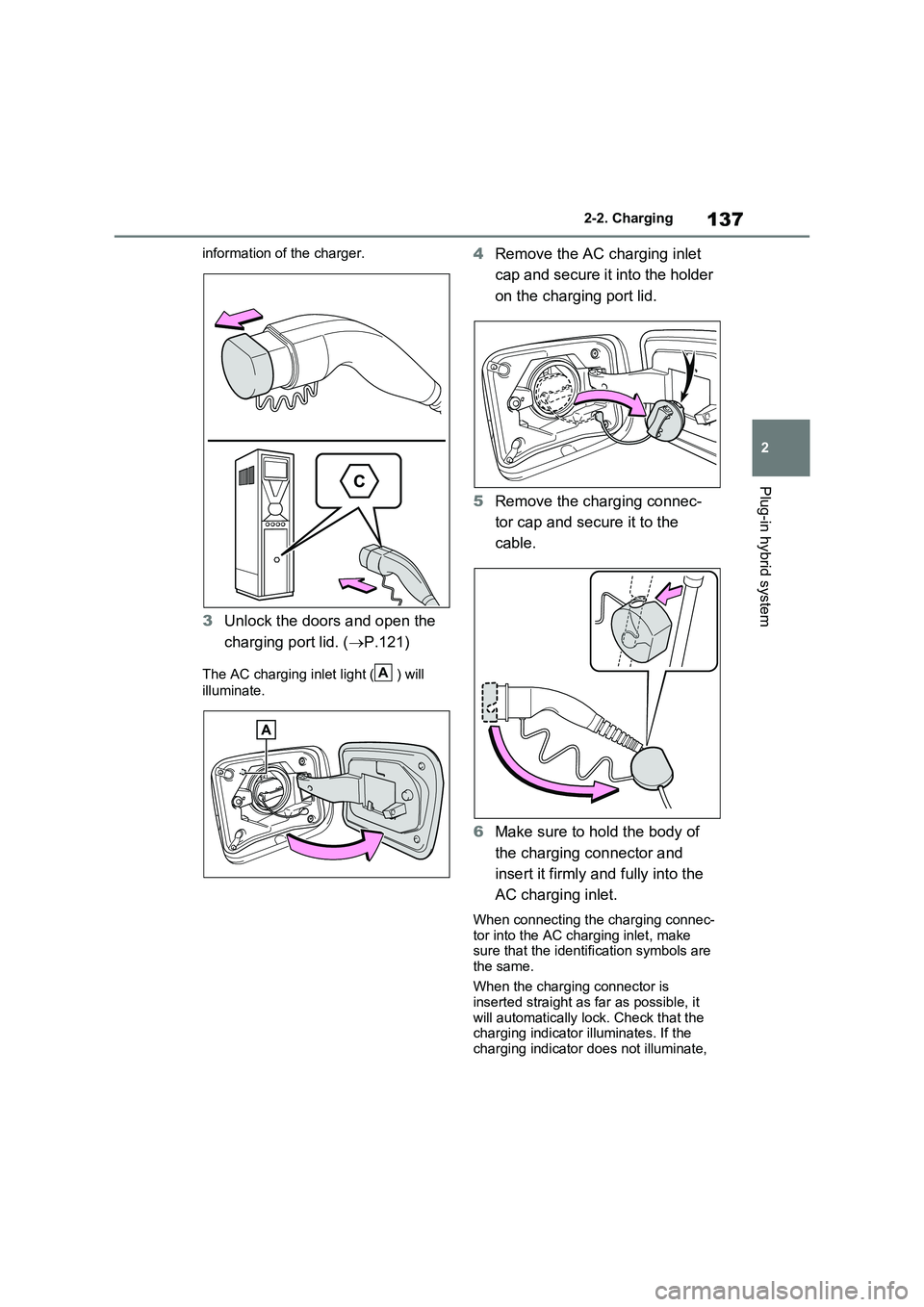
137
2 2-2. Charging
Plug-in hybrid system
information of the charger.
3Unlock the doors and open the
charging port lid. (P.121)
The AC charging inlet light ( ) will
illuminate.
4Remove the AC charging inlet
cap and secure it into the holder
on the charging port lid.
5Remove the charging connec-
tor cap and secure it to the
cable.
6Make sure to hold the body of
the charging connector and
insert it firmly and fully into the
AC charging inlet.
When connecting the charging connec-
tor into the AC charging inlet, make
sure that the identification symbols are
the same.
When the charging connector is
inserted straight as far as possible, it
will automatically lock. Check that the
charging indicator illuminates. If the
charging indicator does not illuminate,
A
Page 140 of 718
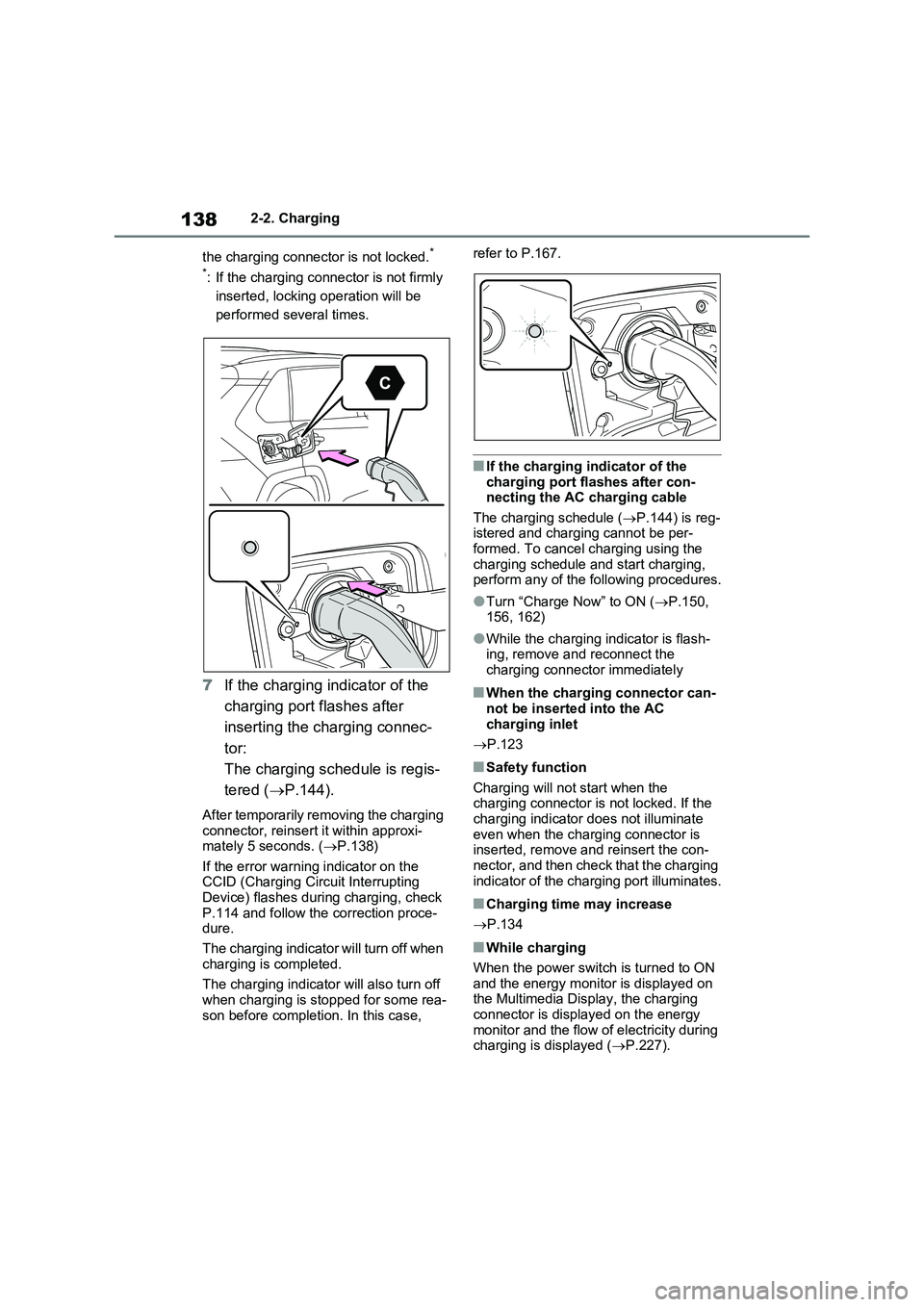
1382-2. Charging
the charging connector is not locked.
*
*
: If the charging connector is not firmly
inserted, locking operation will be
performed several times.
7If the charging indicator of the
charging port flashes after
inserting the charging connec-
tor:
The charging schedule is regis-
tered (P.144).
After temporarily removing the charging
connector, reinsert it within approxi-
mately 5 seconds. (P.138)
If the error warning indicator on the
CCID (Charging Circuit Interrupting
Device) flashes during charging, check
P.114 and follow the correction proce-
dure.
The charging indicator will turn off when
charging is completed.
The charging indicator will also turn off
when charging is stopped for some rea-
son before completion. In this case, refer to P.167.
■If the charging indicator of the
charging port flashes after con-
necting the AC charging cable
The charging schedule (P.144) is reg-
istered and charging cannot be per-
formed. To cancel charging using the
charging schedule and start charging,
perform any of the following procedures.
●Turn “Charge Now” to ON (P.150,
156, 162)
●While the charging indicator is flash-
ing, remove and reconnect the
charging connector immediately
■When the charging connector can-
not be inserted into the AC
charging inlet
P.123
■Safety function
Charging will not start when the
charging connector is not locked. If the
charging indicator does not illuminate
even when the charging connector is
inserted, remove and reinsert the con-
nector, and then check that the charging
indicator of the charging port illuminates.
■Charging time may increase
P.134
■While charging
When the power switch is turned to ON
and the energy monitor is displayed on
the Multimedia Display, the charging
connector is displayed on the energy
monitor and the flow of electricity during
charging is displayed (P.227).
Page 141 of 718

139
2
2-2. Charging
Plug-in hybrid system
■Charging at a public charging sta-
tion with authentication function
When a door is unlocked during charging, the charging connector is
unlocked and charging will be stopped. In this case, the charging station authentication is canceled and charging
may not be able to restart. Reconnect the charging connector and perform authentication for the charging station.
■Protection function of AC charging
inlet overheating (vehicles with 7 kW onboard traction battery char-ger)
By installing a temperature sensor to the AC charging inlet, prevents parts from melting when the temperature rises due
to foreign matter entering the charging connector. When a certain temperature increase is detected, charging is
stopped immediately and a message is displayed on the multi-information dis-play. After the temperature has
decreased, charging resumes by per- forming the operation to start charging again.
WARNING
■When charging
Observe the following precautions.
Failure to do so may cause an unex-
pected accident, resulting in death or serious injury.
●Connect to a power source suitable
for charging. ( P.124)
●Check that the AC charging cable,
plug and socket are free of foreign matter.
●Before charging, check that the AC charging inlet is not deformed, damaged or corroded, and check
that the inlet is free of foreign mat- ter such as dirt, snow and ice. If there is dirt or dust in these areas,
remove completely before inserting the charging connector.
●Before inserting the charging plug into the charger, make sure there is no dirt or dust on the terminal
areas. If there is dirt or dust in these areas, remove completely before inserting the charging plug.
●Do not get the terminals of the AC charging inlet wet.
●Only use sockets where the plug can be securely inserted.
●Do not bundle or wind the AC charging cable while charging, as
doing so may result in overheating.
●Do not touch the terminals of the
charging connector and AC charging inlet with a sharp metal objects (needles etc.) or hands, or
short them with foreign objects.
●When charging outdoors, make
sure to connect to a rain-tight socket for outdoor use. Ensure the rain-tight cover closes completely. If
the rain-tight cover cannot be closed, install a rain-tight cover that will close.
●In order to stop charging at the charging station, follow the instruc-
tions of the charger.
●If any heat, smoke, odors, noise or
other abnormalities are noticed during charging, stop charging immediately.
●Do not insert the plug if the socket is submerged in water or snow.
●When charging while it is raining or snowing, do not connect or discon-
nect the plug if your hands are wet. Also, do not get the plug or outlet wet.
●Do not charge the vehicle during a lightning storm.
●Prevent the AC charging cable from being caught in the door or back
door.
Page 143 of 718
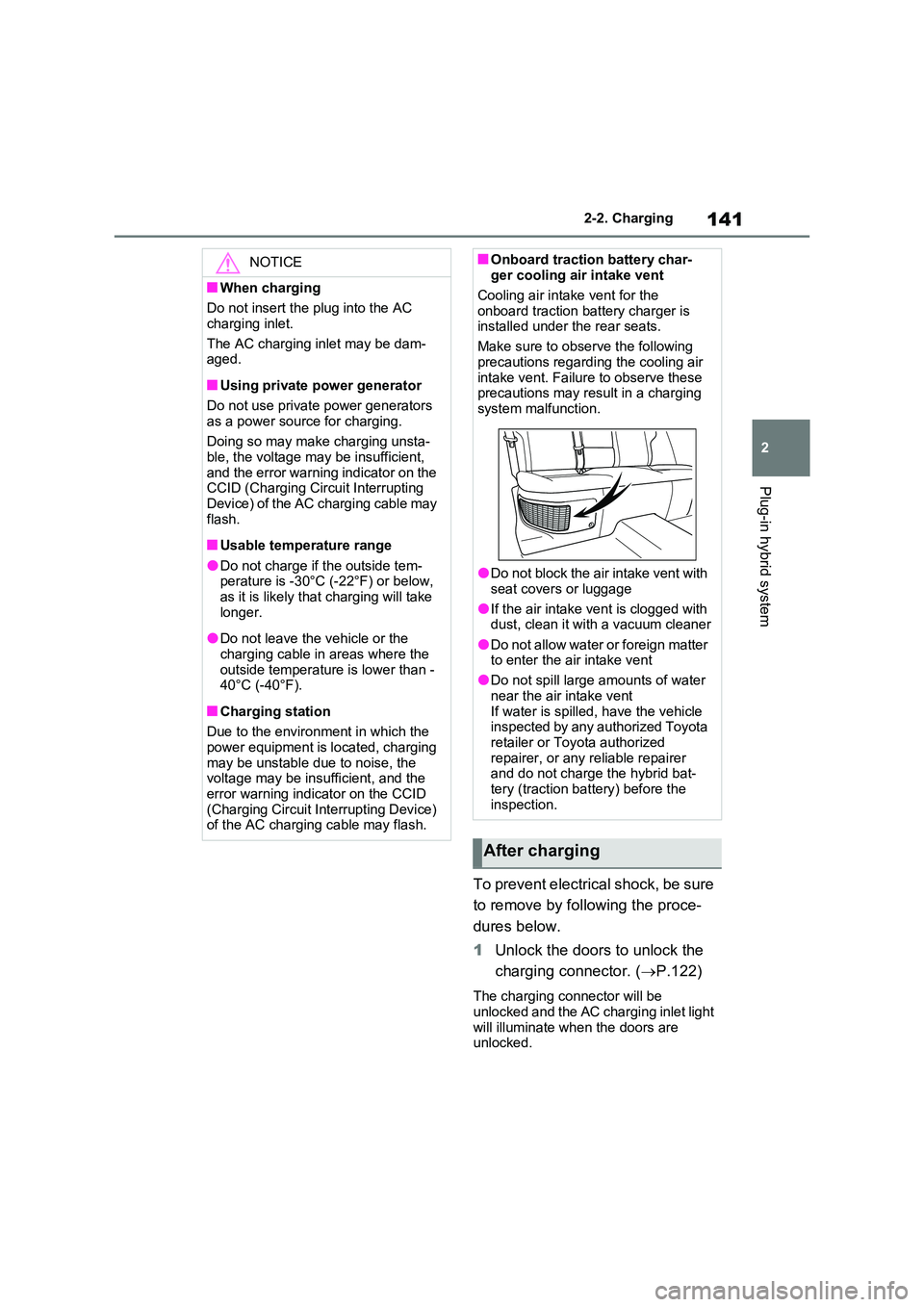
141
2
2-2. Charging
Plug-in hybrid system
To prevent electrical shock, be sure
to remove by following the proce-
dures below.
1 Unlock the doors to unlock the
charging connector. ( P.122)
The charging connector will be
unlocked and the AC charging inlet light will illuminate when the doors are unlocked.
NOTICE
■When charging
Do not insert the plug into the AC
charging inlet.
The AC charging inlet may be dam- aged.
■Using private power generator
Do not use private power generators
as a power source for charging.
Doing so may make charging unsta- ble, the voltage may be insufficient,
and the error warning indicator on the CCID (Charging Circuit Interrupting Device) of the AC charging cable may
flash.
■Usable temperature range
●Do not charge if the outside tem- perature is -30°C (-22°F) or below, as it is likely that charging will take
longer.
●Do not leave the vehicle or the
charging cable in areas where the outside temperature is lower than -40°C (-40°F).
■Charging station
Due to the environment in which the
power equipment is located, charging may be unstable due to noise, the voltage may be insufficient, and the
error warning indicator on the CCID (Charging Circuit Interrupting Device) of the AC charging cable may flash.
■Onboard traction battery char-ger cooling air intake vent
Cooling air intake vent for the
onboard traction battery charger is installed under the rear seats.
Make sure to observe the following
precautions regarding the cooling air intake vent. Failure to observe these precautions may result in a charging
system malfunction.
●Do not block the air intake vent with
seat covers or luggage
●If the air intake vent is clogged with dust, clean it with a vacuum cleaner
●Do not allow water or foreign matter to enter the air intake vent
●Do not spill large amounts of water
near the air intake vent If water is spilled, have the vehicle inspected by any authorized Toyota
retailer or Toyota authorized repairer, or any reliable repairer and do not charge the hybrid bat-
tery (traction battery) before the inspection.
After charging
Page 144 of 718
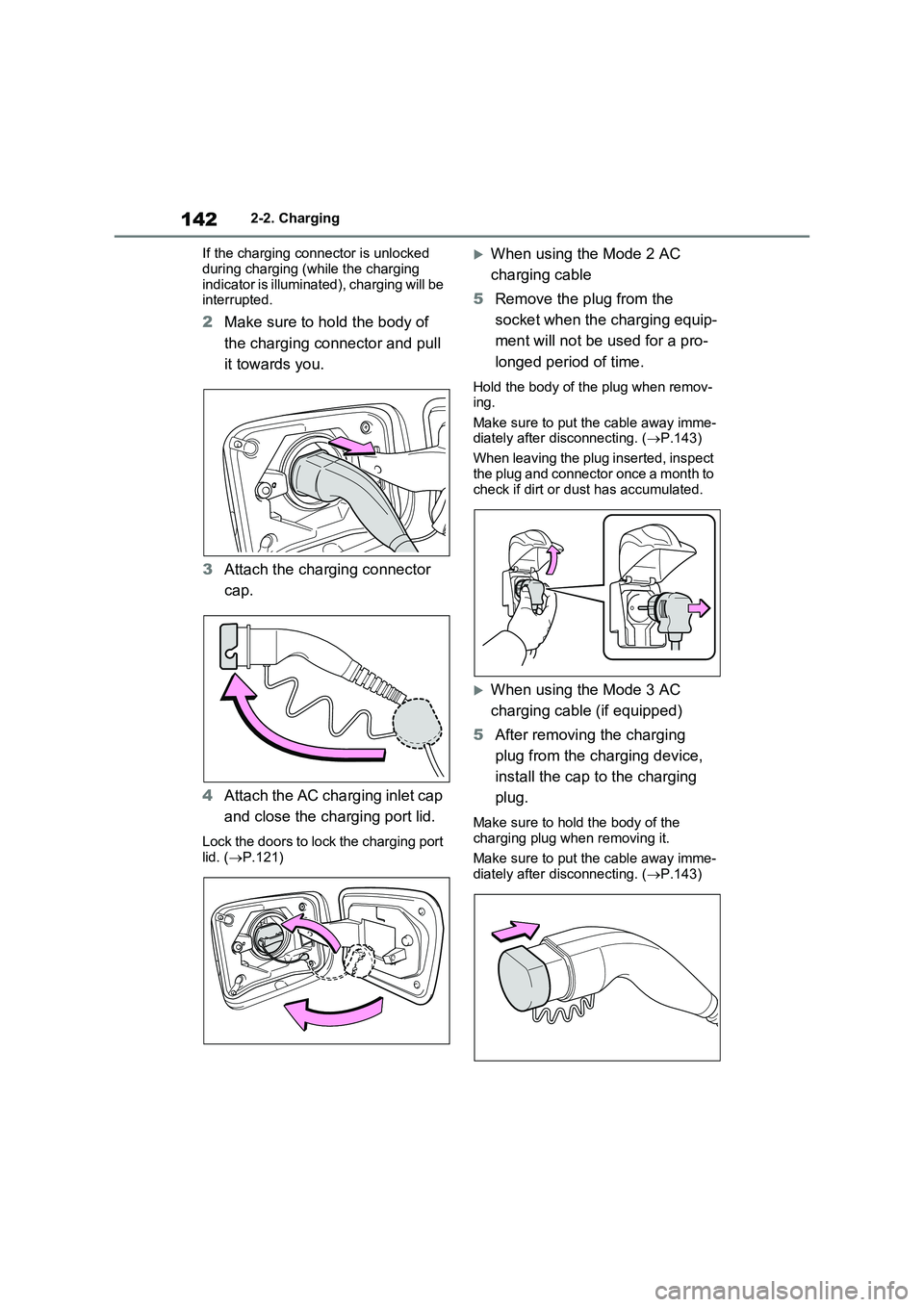
1422-2. Charging
If the charging connector is unlocked
during charging (while the charging indicator is illuminated), charging will be interrupted.
2 Make sure to hold the body of
the charging connector and pull
it towards you.
3 Attach the charging connector
cap.
4 Attach the AC charging inlet cap
and close the charging port lid.
Lock the doors to lock the charging port lid. ( P.121)
When using the Mode 2 AC
charging cable
5 Remove the plug from the
socket when the charging equip-
ment will not be used for a pro-
longed period of time.
Hold the body of the plug when remov- ing.
Make sure to put the cable away imme- diately after disconnecting. ( P.143)
When leaving the plug inserted, inspect
the plug and connector once a month to check if dirt or dust has accumulated.
When using the Mode 3 AC
charging cable (if equipped)
5 After removing the charging
plug from the charging device,
install the cap to the charging
plug.
Make sure to hold the body of the
charging plug when removing it.
Make sure to put the cable away imme- diately after disconnecting. ( P.143)
Page 145 of 718
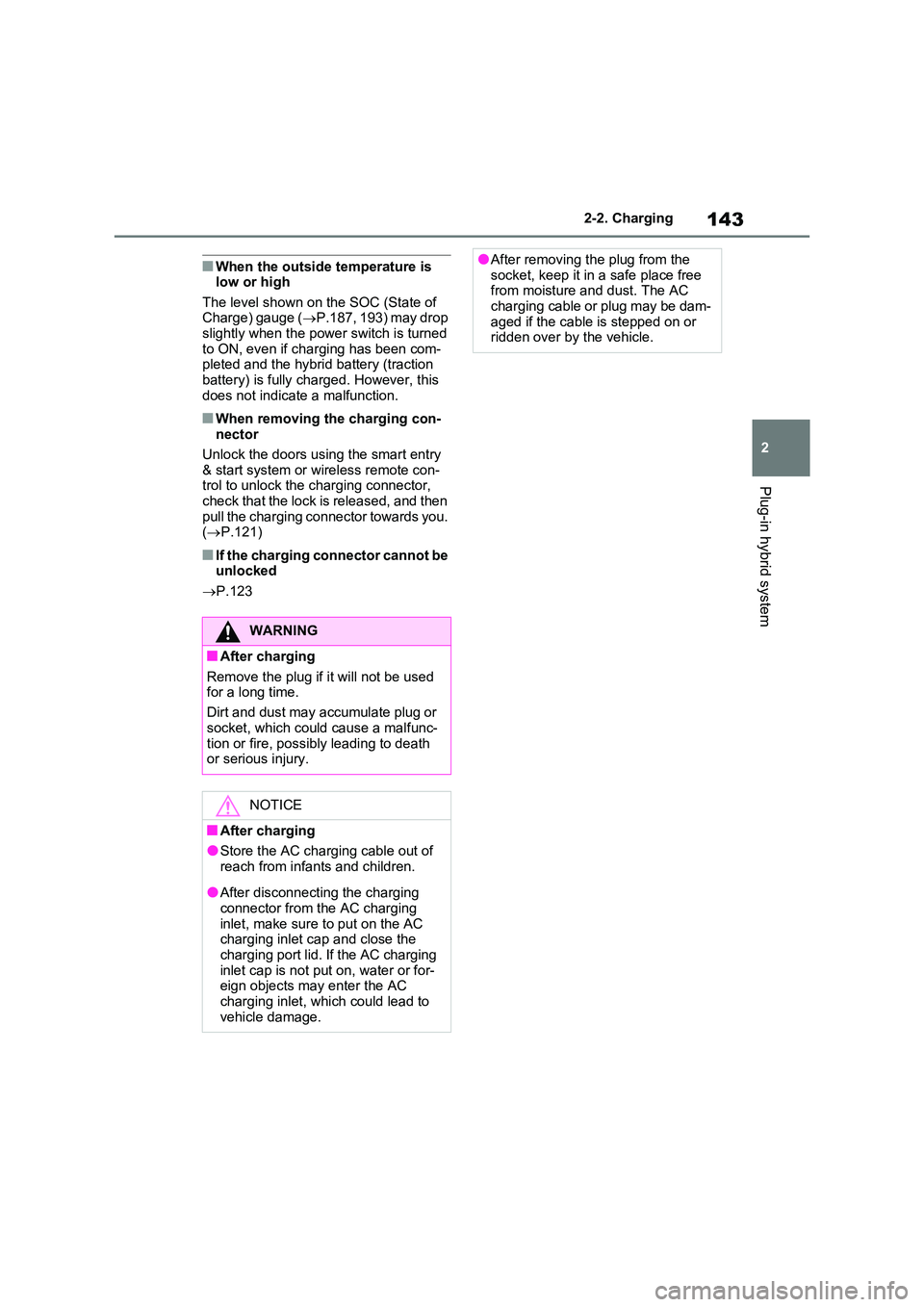
143
2
2-2. Charging
Plug-in hybrid system
■When the outside temperature is low or high
The level shown on the SOC (State of Charge) gauge ( P.187, 193) may drop slightly when the power switch is turned
to ON, even if charging has been com- pleted and the hybrid battery (traction battery) is fully charged. However, this
does not indicate a malfunction.
■When removing the charging con- nector
Unlock the doors using the smart entry
& start system or wireless remote con- trol to unlock the charging connector, check that the lock is released, and then
pull the charging connector towards you. ( P.121)
■If the charging connector cannot be unlocked
P.123
WARNING
■After charging
Remove the plug if it will not be used for a long time.
Dirt and dust may accumulate plug or
socket, which could cause a malfunc- tion or fire, possibly leading to death or serious injury.
NOTICE
■After charging
●Store the AC charging cable out of
reach from infants and children.
●After disconnecting the charging
connector from the AC charging inlet, make sure to put on the AC charging inlet cap and close the
charging port lid. If the AC charging inlet cap is not put on, water or for-eign objects may enter the AC
charging inlet, which could lead to vehicle damage.
●After removing the plug from the socket, keep it in a safe place free from moisture and dust. The AC
charging cable or plug may be dam- aged if the cable is stepped on or ridden over by the vehicle.
Page 146 of 718
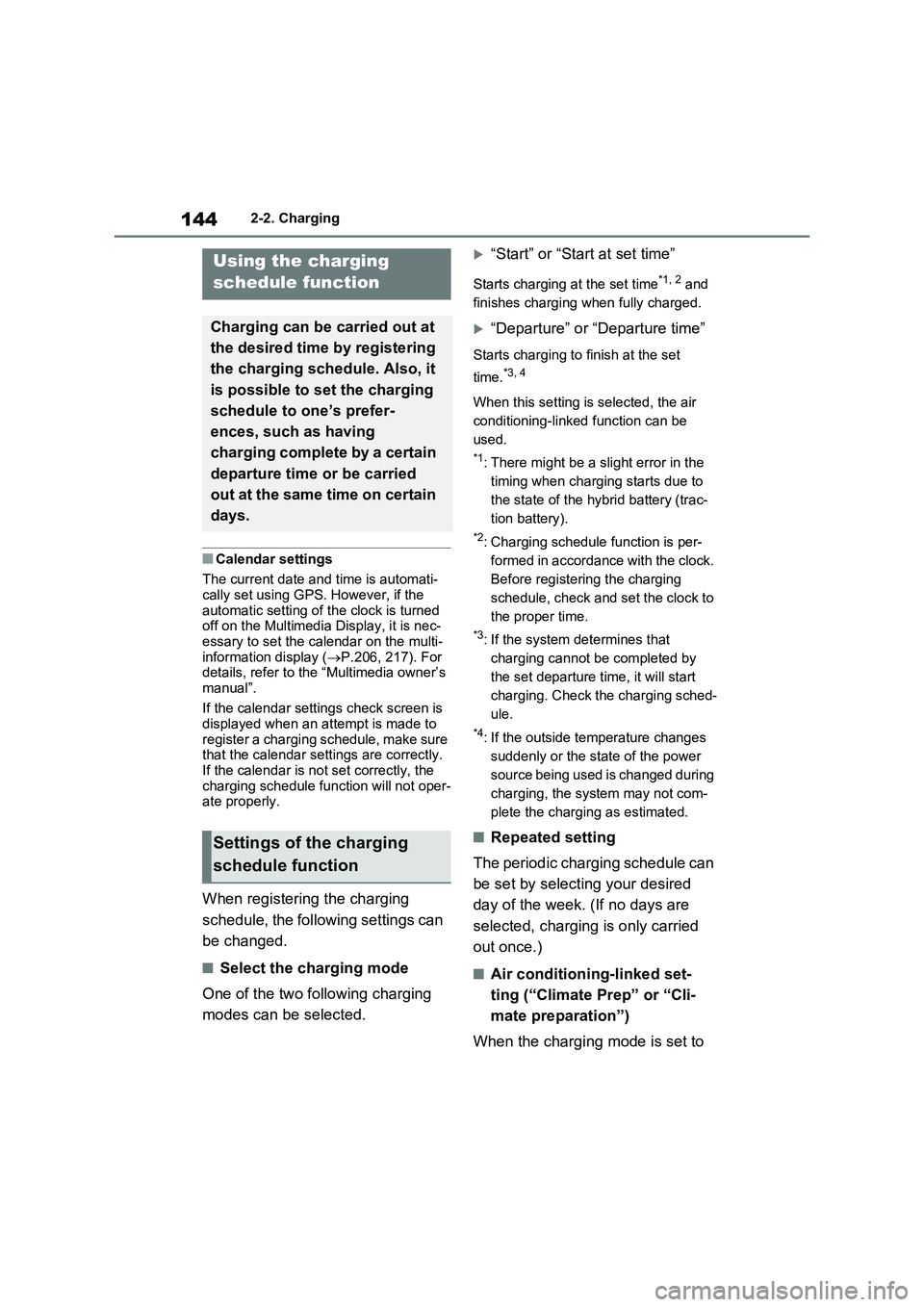
1442-2. Charging
■Calendar settings
The current date and time is automati-
cally set using GPS. However, if the
automatic setting of the clock is turned
off on the Multimedia Display, it is nec-
essary to set the calendar on the multi-
information display (P.206, 217). For
details, refer to the “Multimedia owner’s
manual”.
If the calendar settings check screen is
displayed when an attempt is made to
register a charging schedule, make sure
that the calendar settings are correctly.
If the calendar is not set correctly, the
charging schedule function will not oper-
ate properly.
When registering the charging
schedule, the following settings can
be changed.
■Select the charging mode
One of the two following charging
modes can be selected.
“Start” or “Start at set time”
Starts charging at the set time*1, 2 and
finishes charging when fully charged.
“Departure” or “Departure time”
Starts charging to finish at the set
time.
*3, 4
When this setting is selected, the air
conditioning-linked function can be
used.
*1: There might be a slight error in the
timing when charging starts due to
the state of the hybrid battery (trac-
tion battery).
*2: Charging schedule function is per-
formed in accordance with the clock.
Before registering the charging
schedule, check and set the clock to
the proper time.
*3: If the system determines that
charging cannot be completed by
the set departure time, it will start
charging. Check the charging sched-
ule.
*4: If the outside temperature changes
suddenly or the state of the power
source being used is changed during
charging, the system may not com-
plete the charging as estimated.
■Repeated setting
The periodic charging schedule can
be set by selecting your desired
day of the week. (If no days are
selected, charging is only carried
out once.)
■Air conditioning-linked set-
ting (“Climate Prep” or “Cli-
mate preparation”)
When the charging mode is set to
Using the charging
schedule function
Charging can be carried out at
the desired time by registering
the charging schedule. Also, it
is possible to set the charging
schedule to one’s prefer-
ences, such as having
charging complete by a certain
departure time or be carried
out at the same time on certain
days.
Settings of the charging
schedule function